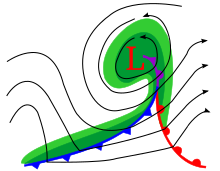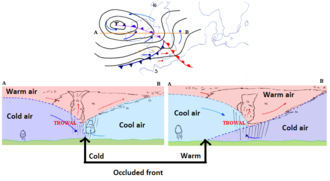79:
20:
145:
A cold front is diagrammed as spikes pointing to its direction of travel. A warm front is shown as semi-circles in a traditional weather map, also pointing to its direction of travel. An occluded front is a combination of those two signs: they are indicated on a weather map either by a purple line
162:
is significant along the cold front. Small isolated occluded fronts often remain for a period after a low-pressure system has decayed and disappeared and these create cloudy conditions with patchy areas of rain or showers.
153:
A wide variety of weather can be found along an occluded front, with heavy thunderstorms and tornadoes possible, but usually, their passage is instead associated with a drying of the air mass. Additionally, cold core
114:, the cool air mass overtaking the warm front is warmer than the cold air ahead of the warm air mass and rides over the colder air mass while lifting the warm air, and often has the characteristics of a warm front.
146:
with alternating semicircles and triangles pointing to the direction of travel, or by red semicircles and blue triangles pointing to the direction of travel. On the other hand, a TROWAL is diagrammed on
134:
is often offset from the range of the associated weather which occurs at the TROWAL. The TROWAL, is primarily found with a connection to the warm occlusion, and are rarely seen in cold occlusion.
130:
oft), is the estimated projection of the wedge of warm air above the surface, and is at the same position in both cases. Consequently, the location of the occluded front appearing in the
107:, the cold air mass that overtakes the warm air mass ahead is colder than the cool air at the very front and plows under both air masses, and often has the characteristics of a cold front.
166:
However, the clouds and precipitation are not really the location where the projection on the Earth's surface of the occluded front is, but it is with the TROWAL position.
63:. A more modern view of the formation process suggests that occluded fronts form directly without the influence of other fronts during the wrap-up of the
118:
The occluded front symbol should show where the cold air intersects the surface. It thus varies between warm and cold occlusions. The TROWAL (short for
142:
One symbol of an occluded front is the TROWAL symbol with alternating blue and red lines similar to a cold/warm front junction
56:
72:
224:
190:
131:
239:
202:
180:
150:
maps by the junction of blue and red lines like the junction of cold and warm fronts aloft.
8:
51:
center at the surface. The point where the warm front becomes the occluded front is the
92:
219:
185:
215:
23:
Diagram of a cyclone in the early stages of occlusion in the
Northern Hemisphere
203:
Occluded fronts and the occlusion process: A fresh look at conventional wisdom.
82:
Occlusion principle with positions of warm/cold occlusion fronts and the trowal
233:
39:. The classical and usual view of an occluded front is that it starts when a
32:
155:
95:. There are two types of front occlusions, warm and cold, depending on the
68:
36:
96:
78:
64:
47:
near a cyclone, such that the warm air is separated (occluded) from the
159:
44:
40:
19:
175:
147:
48:
16:
Meteorological interaction of warm and cool air masses
75:
and rotation around the cyclone as the cyclone forms.
205:Bull. Amer. Meteor. Soc., 92, 443–466, ES19–ES20.
216:AIR MASSES AND FRONTS - THE OCCLUDED FRONT (1962)
231:
91:Occluded fronts usually form around mature
86:
77:
59:that develops at this point is called a
18:
232:
201:Schultz, D. M., and G. Vaughan, 2011:
13:
137:
14:
251:
208:
218:is available for viewing at the
71:, and then lengthen due to flow
1:
196:
7:
169:
10:
256:
191:Surface weather analysis
132:surface weather analysis
83:
24:
181:Extratropical cyclone
87:Features and variants
81:
22:
158:are possible if the
57:area of low-pressure
27:In meteorology, an
93:low pressure areas
84:
25:
247:
220:Internet Archive
186:Stationary front
61:triple-point low
255:
254:
250:
249:
248:
246:
245:
244:
230:
229:
225:Occluded Front.
211:
199:
172:
140:
138:Related weather
89:
65:baroclinic zone
17:
12:
11:
5:
253:
243:
242:
240:Weather fronts
228:
227:
222:
210:
209:External links
207:
198:
195:
194:
193:
188:
183:
178:
171:
168:
139:
136:
116:
115:
112:warm occlusion
108:
105:cold occlusion
88:
85:
35:formed during
29:occluded front
15:
9:
6:
4:
3:
2:
252:
241:
238:
237:
235:
226:
223:
221:
217:
213:
212:
206:
204:
192:
189:
187:
184:
182:
179:
177:
174:
173:
167:
164:
161:
157:
156:funnel clouds
151:
149:
143:
135:
133:
129:
125:
121:
113:
109:
106:
102:
101:
100:
98:
94:
80:
76:
74:
70:
66:
62:
58:
54:
50:
46:
42:
38:
34:
33:weather front
31:is a type of
30:
21:
214:A film clip
200:
165:
152:
144:
141:
127:
123:
119:
117:
111:
104:
90:
69:cyclogenesis
60:
53:triple point
52:
43:overtakes a
37:cyclogenesis
28:
26:
99:contrast:
97:temperature
73:deformation
197:References
160:wind shear
45:warm front
41:cold front
234:Category
170:See also
126:arm air
55:; a new
176:Cyclone
148:weather
122:ugh of
67:during
49:cyclone
110:In a
103:In a
120:TRO
236::
128:AL
124:W
Text is available under the Creative Commons Attribution-ShareAlike License. Additional terms may apply.

